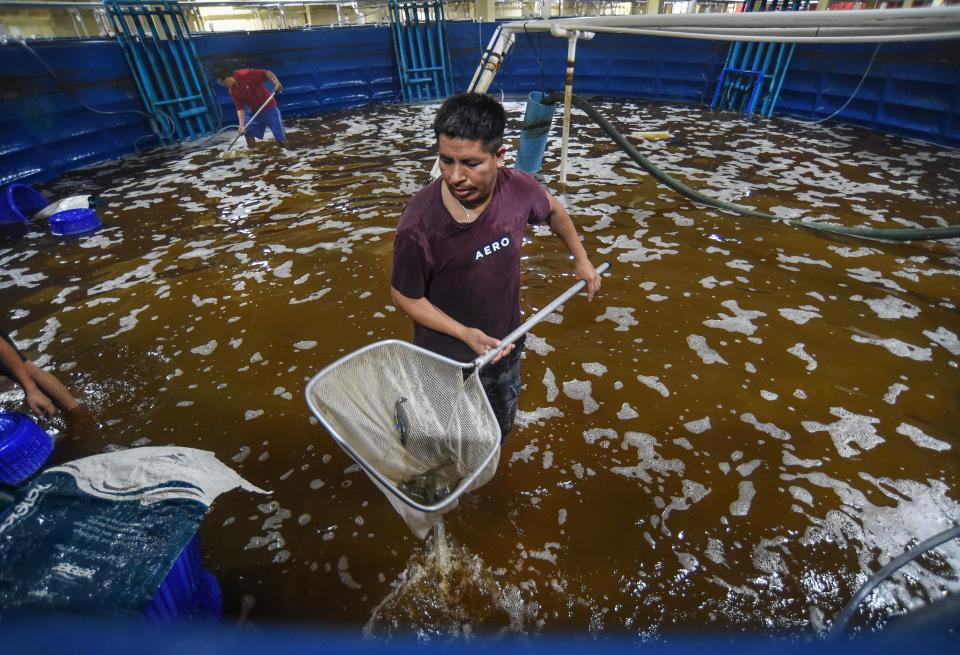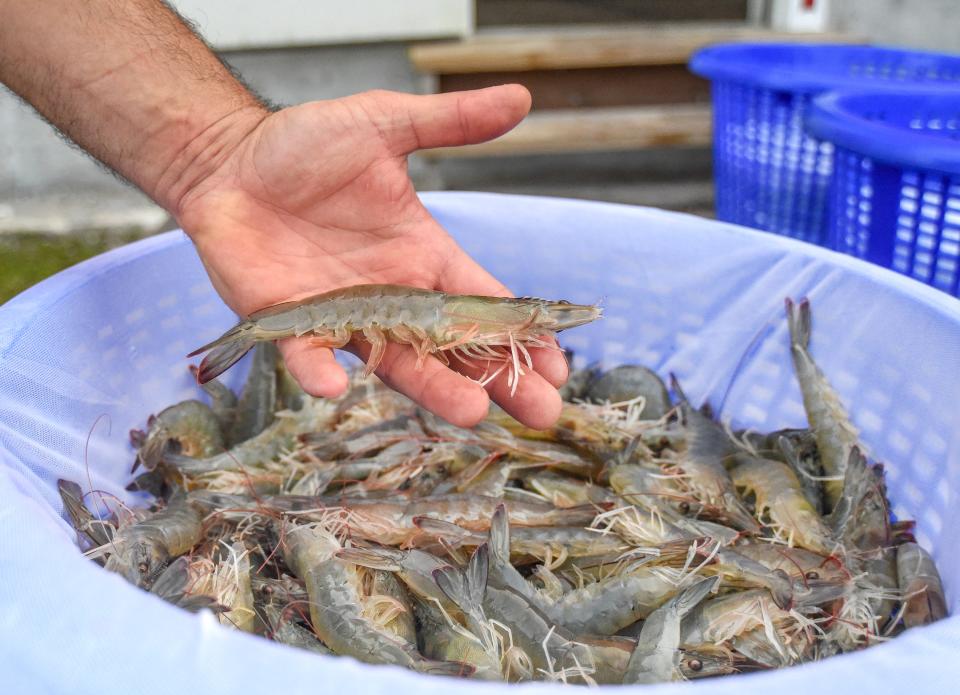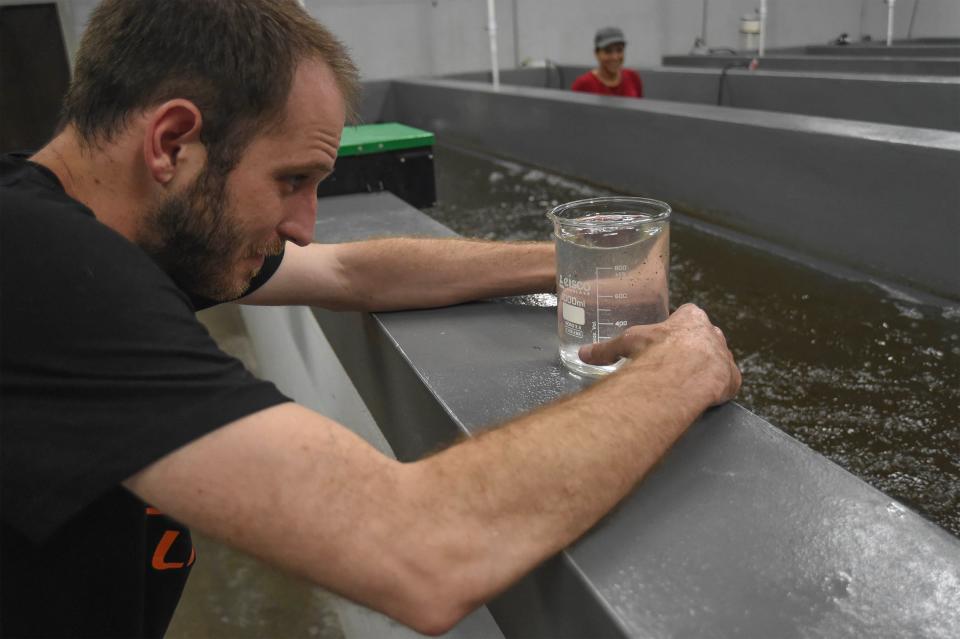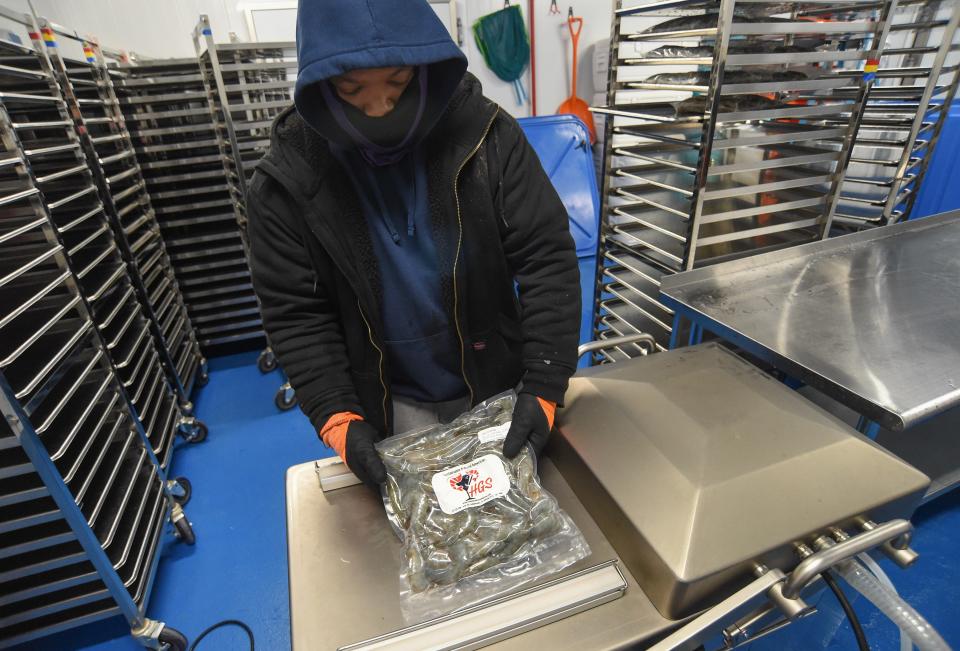Treasure Coast shrimp farm aims to be global supplier of delicious, sustainable shrimp
Julio Jose and Manuel Andres are immersed waist-deep in 75-degree water in a 100-ton poly tank. Armed with large mesh dip nets, they begin their weekly task of shrimp wrangling. Even though the shrimp are jumbo size, it's challenging to scoop up 1,200 shrimp that are swimming around in a 20-foot-diameter tank.
This is harvest day at HomeGrown Shrimp, an innovative, state-of-the-art indoor aquaculture farm on the Treasure Coast that raises about 275 tons of Pacific white shrimp a year — and aims to become a global supplier. So one day, the shrimp you eat in restaurants or buy in seafood shops and grocery stores could come from here.
The company claims the way it raises its shrimp makes it better than wild-caught shrimp — not only for your health and eating pleasure, but for the environment.
"We are ready to supply small grocers, but not quite ready to supply food service distributors and major chains yet," said Executive Vice President Robins McIntosh. "Our goal is to demonstrate that by farming shrimp, we can meet that demand and more. Once we're fully operational, we can produce from 600 to 1,000 tons [1.2 million to 2 million pounds] of shrimp each year here."
Where can I find farm-raised fresh shrimp?
The shrimp, also called whiteleg or king prawn, is a saltwater shrimp common in the Pacific Ocean's warm eastern waters between Mexico and Peru. Known for their large size, savory taste and ease of use in a wide variety of seafood dishes, they're one of the most common shrimp found in aquaculture operations in as many as 27 Latin American and Southeast Asian countries.
You can buy HomeGrown Shrimp direct from the Indiantown farm, or have it shipped to you overnight. You can also buy it from Blu Arroz Asian Bistro in Stuart and Kai-Kai Farm in Indiantown.
Prices are $25 for 2 pounds of 32-40 count and $62.50 for 5 pounds of 50-80 count, with the heads and tails still on the one-ounce shrimp. That's about half the price at some Treasure Coast seafood markets and one-third less than frozen Gulf and Key West pinks in large retail grocery stores.

The company is seeking more business partners like Blu Arroz and Kai-Kai that will buy their shrimp for a discounted price and place a small freezer in their store, which HomeGrown Shrimp will restock weekly — with no contract or commitment. The company also hopes more local restaurants will serve their shrimp.
"We're really just trying to get our shrimp out there to people," said Christine McCann, the processing and shipping manager.
Is farm-raised better than wild-caught?
Pacific white shrimp is rated as a "Best Choice" for being farmed responsibly, according to the Monterey Bay Aquarium's nonprofit Seafood Watch program, which claims to be the leading source of science-based information for sustainable seafood around the world.

The wild-caught shrimp bycatch rate is as high as 80%, according to the Smithsonian Institute, meaning for every 1 pound of wild-caught shrimp, 4 pounds of other fish and marine life are caught and discarded overboard.
After seeing such waste first-hand for many years, Jake Deitzel was happy to leave his job as a federal observer on Gulf of Mexico shrimp boats for the NOAA National Marine Fisheries Service. Now he's HomeGrown Shrimp's hatchery manager.
"I was shocked at how much fish went over the side of those boats, dead, simply because they weren't the target species. I wanted to be part of an operation that was sustainable and better for the environment," he said.
The company says its shrimp is free of disease, antibiotics, hormones and preservatives such as polyphosphates, McIntosh said. The shrimp is superior in taste, texture and uniform size, he added.
"There is no competition with wild-caught," McIntosh said.

The problem is most people don't know where their food comes from, and shrimpers — who represent only a fraction of the market — have convinced consumers wild-caught is better, McIntosh said.
Americans eat about 20.5 pounds of seafood each year, the majority of which is shrimp, at 5.9 pounds, according to 2021 data from the National Fisheries Institute.
The U.S. imports 1.7 billion pounds of that shrimp, according to SeafoodSource, a commercial fishing trade publication. Only 186.5 million pounds of that are wild-caught, according to the National Marine Fisheries Services' commercial landings data.
HomeGrown Shrimp's sustainability

HomeGrown Shrimp is the first U.S. aquaculture farm operated by CPF Foods of Thailand, which exports millions of pounds of shrimp each year. The company opened its 20-acre farm in 2018 and is ready to double its size on an adjacent 20 acres it owns when the market catches up to production, McIntosh said.
The site was home to another company's failed operation, which used ponds to raise its shrimp. HomeGrown Shrimp knew it had to build a hatchery to grow delicious, sustainable shrimp.
The self-sustaining operation grows its own microalgae to feed the larvae and pellets to feed the shrimp, and creates its own saltwater by adding salt to groundwater pulled from a well.
The entire system is contained and the workers are bound to strict cleanliness precautions, so it's impossible for shrimp or diseases to escape into the wild, McIntosh said.
Because shrimp won't spawn or lay eggs during daylight, artificial lighting in the buildings mimic nighttime conditions so workers can work during the day.
One critical component of the operation is keeping a brood stock on hand and in rotation to constantly produce new larvae. Brood males and females are kept in the same spawning tank. A "bolt line" down a female's back means she's ready to produce eggs in 1-2 days. Then the process takes about 80 days as workers transfer:
Eggs into a hatching tank
Larvae into a nursery tank. Some are sold to other shrimp farms in the U.S. and Europe because the company currently raises more shrimp than it sells for food.
Juvenile shrimp into a grow house with 40 tanks holding 100 tons of water each, and eight tanks to recirculate water and remove waste. The shrimp are managed by age to ensure consistency of size during harvest.
To contact the company about buying or shipping shrimp or accepting a freezer in your store, contact HomeGrown Shrimp at HomeGrownShrimp-USA.com or call 772-597-8484.
Ed Killer is a reporter with TCPalm. He can be reached at ed.killer@tcpalm.com.
This article originally appeared on Treasure Coast Newspapers: Jumbo shrimp farm raises sustainable seafood in Indiantown

